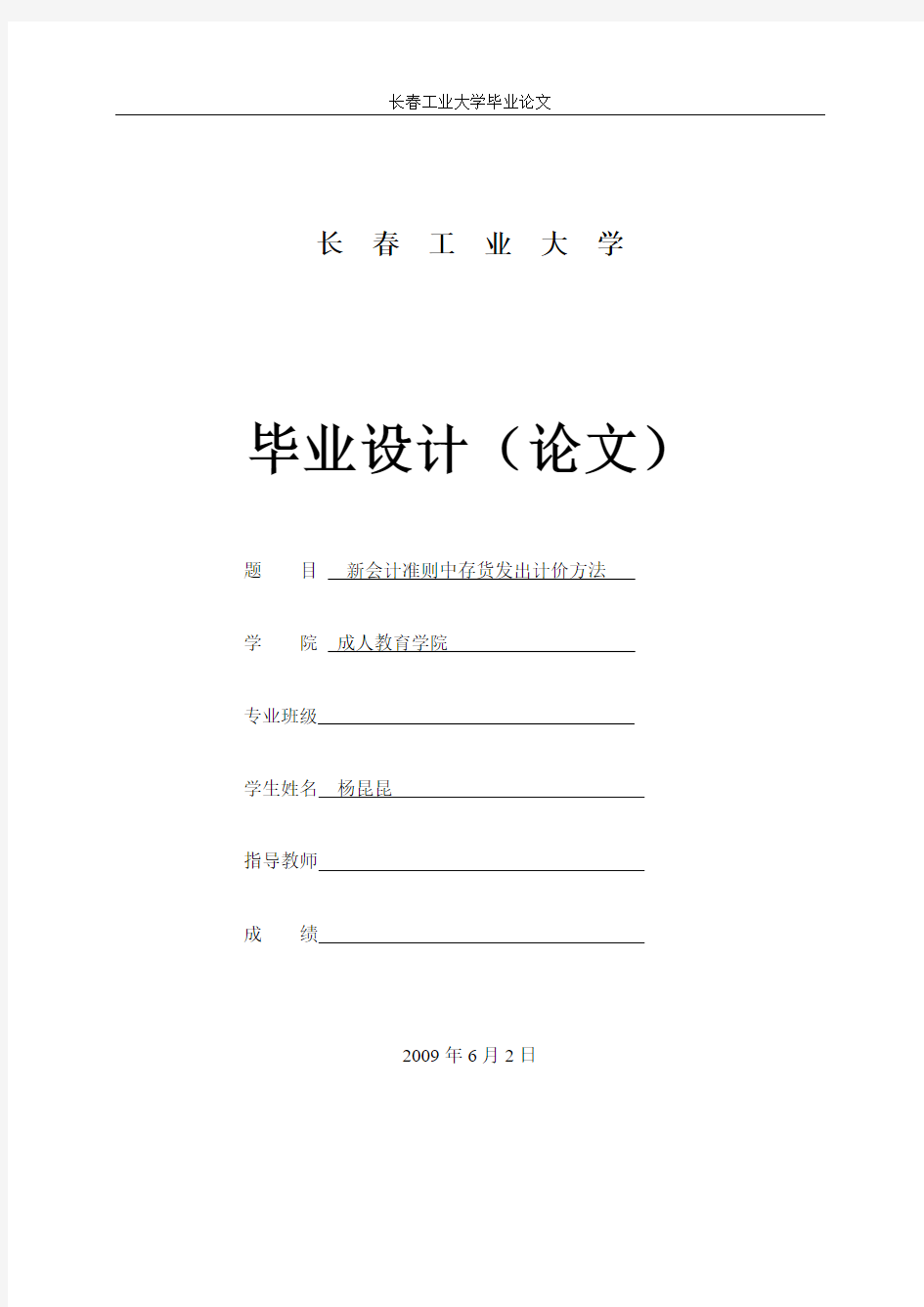新会计准则中存货发出计价方法汇总.

- 1、下载文档前请自行甄别文档内容的完整性,平台不提供额外的编辑、内容补充、找答案等附加服务。
- 2、"仅部分预览"的文档,不可在线预览部分如存在完整性等问题,可反馈申请退款(可完整预览的文档不适用该条件!)。
- 3、如文档侵犯您的权益,请联系客服反馈,我们会尽快为您处理(人工客服工作时间:9:00-18:30)。
长春工业大学
毕业设计(论文)题目新会计准则中存货发出计价方法
学院成人教育学院
专业班级
学生姓名杨昆昆
指导教师
成绩
2009年6月2日
摘要
摘要:存货是企业一项很重要的资产,在企业资产总额中所占比重较大,它的积压或者数量过多都会影响到企业正常生产经营活动的展开。因此企业选择存货的计价方法直接影响着企业资产价值、产品成本及经营成果的核算。不同的存货计价方法会直接影响期末存货价值的确定和销售成本的计算,进而对企业的利润、税收负担、现金流量财务比率等产生影响。
随着我国会计国际化的进程逐步加快,其中新会计准则对存货计价的方法作出新的规定,企业应当采用先进先出法、加权平均法或者个别计价法确定发出存货的实际成本,取消了后进先出法。这是我国政府根据经济发展的实际状况进行会计体系建设的重要部分,总体上有利于经济的发展和企业的长久发展,也有利于我国企业更好地参与国际经济活动。
关键字:新会计准则,存货发出计价方法,应用
Abstract
Inventory is a very important business assets, total assets in the enterprise a larger share of it too much of the backlog or the number of enterprises will affect the normal production and operation activities. Therefore choose the inventory valuation method with a direct impact on the value of enterprise assets, product cost and operating results, accounting. Different methods of inventory valuation will directly affect the value of inventory at the end of the identification and calculation of cost of sales, and profits of enterprises, the tax burden on financial ratios such as cash flow impact.
With the internationalization of China's accounting and gradually speed up the process, in which the new accounting standards for inventory valuation methods to the new requirements, enterprises should adopt FIFO method, the weighted average method or the issue of individual inventory valuation method to determine the actual costs, the abolition of the backward first-out method. This is in accordance with the actual situation of the economic development of the accounting system for an important part of the whole, conducive to economic development and long-term development of enterprises, but also conducive to China's enterprises to better participate in international economic activities.
Key Words:New accounting standards, issued inventory valuation methods, application
目录
摘要 (Ⅰ)
Abstract (Ⅱ)
一、总论 (1)
(一)存货概述 (1)
1.存货含义 (1)
2.存货的基本内容 (1)
(二)发出存货计价的依据及发出存货计价方法的标准 (2)
1. 存货计价的依据 (2)
2. 存货计价方法的标准 (2)
二、发出存货计价方法 (3)
(一) 个别计价法 (3)
(二)后进先出法 (4)
(三)加权平均法 (5)
三、后进先出法的取消 (6)
(一)后进先出法的概述 (6)
1.后进先出法的优点 (6)
2.后进先出法的缺点 (6)
(二)后进先出法在应用中存在的问题 (7)
1.常被用作调节利润的工具 (7)
2.计算结果受盘存制度的影响 (7)
3.“后入库的先出库”存货流动假设的影响 (8)
(三)后进先出法取消的原因 (9)
1.日常工作量大 (9)
2.后进先出法的假设与实际情理不符 (9)
3.在通货膨胀下体现谨慎性原则的优势已明显被弱化 (10)
4.后进先出法取消的合理性、国际趋同的需要 (10)
四、新旧会计准则中存货发出计价方法的差别 (12)
(一)新旧会计准则中存货发出计价方法的差别 (12)
1.存货发出计价方法的差别 (12)
2.新旧准则后进先出法的差别 (12)
五、新会计准则存货发出计价方法对企业的影响 (14)
(一)发出存货计价方对企业会计信息产生的影响 (14)
